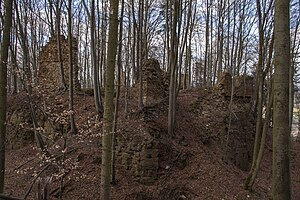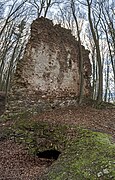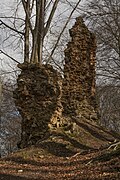Haimburg castle ruins
| Haimburg castle ruins | ||
|---|---|---|
|
Haimburg castle ruins |
||
| Creation time : | 12th Century | |
| Castle type : | Hilltop castle | |
| Conservation status: | Remains of gateways and keep | |
| Standing position : | Nobles, Reichsministeriale | |
| Place: | Haimburg in the municipality of Berg near Neumarkt in the Upper Palatinate | |
| Geographical location | 49 ° 21 '5.7 " N , 11 ° 26' 51.5" E | |
| Height: | 550 m above sea level NN | |
|
|
||
The Haimburg castle ruins are the ruins of a hilltop castle at 550 m above sea level. NN high elevation above the district Haimburg of the municipality Berg near Neumarkt in the Upper Palatinate in the Upper Palatinate district of Neumarkt in the Upper Palatinate in Bavaria .
The castle ruins are freely accessible at all times, but there is a risk of collapse.
history
The castle was first mentioned in a certificate from Emperor Heinrich III. mentioned. It was built by the Lords of Haimburg, a branch line of the Lords of Stein. The last sole owner was Heinrich II von Haimburg (1333-1362). After his death, the property was divided and his nephew Heinrich III received one half. von Stein (1362-1361), the other his brother, the Regensburg Bishop Konrad VI. from Haimberg . After several changes of ownership, Haimburg came into the possession of Prince Elector Ruprecht I in 1388. After merging with the Troßberg office , the Haimburg nursing office was established in Bavaria. From 1410 Count Palatine Johann von Neumarkt was the owner of the complex and in 1434 expanded it into a magnificent hunting lodge .
The castle suffered considerable damage in the course of the Landshut War of Succession . It was conquered and burned down on July 8, 1504 by the Nuremberg people. The Nuremberg residents received Gnadenberg and Haimburg from Emperor Maximilian I. as a reward for helping in the Landshut War of Succession. Count Palatine Friedrich II was able to get both possessions back into his hands through a contract with the Nuremberg residents in 1521 and repair the Haimburg.
The Thirty Years War also brought calamity to Haimburg: On October 3, 1634, the castle was conquered by the imperial troops. After being plundered several times, it was burned down by the Swedes in 1648 because the Nuremberg residents had refused to pay them 600 guilders.
description
Remains of a round keep , two gateways as well as remains of the foundation wall, cellar vaults and a deep double neck moat are still preserved from the castle complex. These parts go back to the 15th and 16th centuries, the lower parts of the castle ring are likely to date from the Romanesque period .
literature
- Ursula Pfistermeister : Castles of the Upper Palatinate . Verlag Friedrich Pustet, Regensburg 1974, ISBN 3-7917-0394-3 , p. 87.
- Friedrich-Wilhelm Krahe: Castles of the German Middle Ages - floor plan lexicon . Flechsig Verlag, Würzburg 2000, ISBN 3-88189-360-1 , p. 241.
- Günter Moser, Bernhard Setzwein, Mathias Conrad: Upper Palatinate Castles - A journey to the witnesses of the past . Buch and Kustverlg Oberpfalz, Amberg 2004, ISBN 3-935719-25-6 , pp. 98-99.
- Robert Giersch, Andreas Schlunk, Berthold Frhr. von Haller: Castles and mansions in the Nuremberg countryside . Altnürnberger Landschaft, Lauf an der Pegnitz 2006, ISBN 978-3-00-020677-1 , pp. 160–163.
- Herbert Rädle, Günther Enzmann: Castles and fortress stables in the Neumarkt district . Published by the district of Neumarkt in der Oberpfalz, Neumarkt o. J., ISBN 3-920142-14-4 , pp. 40–42.
- Rudolf Wieneth: Palatine- Counts' places of activity. In: Hans Fischer, Manfred Kindler, Theo Männer, Peter Pauly, Otto Reimer and Rudolf Wisneth (eds.): Festschrift for the Pfalzgraf-Johann year 1983. Neunburg vorm Wald: Schmiedl, 1983, pp. 60–68.
Web links
- Haimburg castle ruins on the castles and manors side in the Nuremberg countryside
- Burgruine Haimburg on the side , etc. page
- Haimburg castle ruins on the Burgenwelt side









